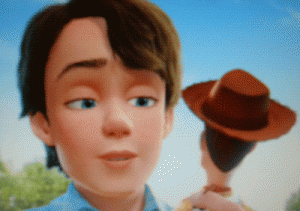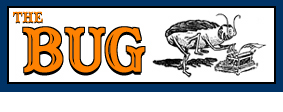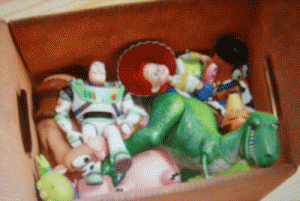 Toy Story 3, 2010. Directed by Lee Unkrich, written by Michael Arndt. With the vocal talents of Tom Hanks, Tim Allen, Joan Cusack, Ned Beatty, Don Rickles, Michael Keaton, Wallace Shawn, John Ratzenberger, Estelle Harris, Teddy Newton, Bud Luckey (incredible), Javier Fernandez Pena, and Timothy Dalton and Kristen Schall, both utterly wasted in miniscule roles.
Toy Story 3, 2010. Directed by Lee Unkrich, written by Michael Arndt. With the vocal talents of Tom Hanks, Tim Allen, Joan Cusack, Ned Beatty, Don Rickles, Michael Keaton, Wallace Shawn, John Ratzenberger, Estelle Harris, Teddy Newton, Bud Luckey (incredible), Javier Fernandez Pena, and Timothy Dalton and Kristen Schall, both utterly wasted in miniscule roles.
Is it fair to criticize a very good movie because it fails to live up to nearly impossible standards? Case in point: Toy Story 3. Look at Pixar’s last six years. The Incredibles. Cars. Ratatouille. Wall*E. Up. Excepting Cars, you’ve got four of the best movies a studio has put out probably since Paramount hit the jackpot with Robert Evans in the mid 70s. I would argue it exceeds anything Disney has ever done in a six year stretch of time, and would go so far as to say that those four are better than any four of Walt’s films ever. So with this in mind, I ask again: is it fair to say that Toy Story 3, unquestionably the finest film this summer, and exciting and at times touching movie, pales in comparison? That I expect more from Pixar? Or is this critic spoiled?
Let me put it to you straight that I’m no great fan of the first Toy Story. It was fun, but a bit maudlin at times, and being Pixar’s first effort, they still hadn’t mastered humans quite yet. Having committed to making Andy and his family look like real humans instead of the Mad Magazine-style look of Brad Bird’s people in The Incredibles and Ratatouille, they slipped into the uncanny valley.
Simply put, the humans are creepy in Toy Story. (A problem they momentarily fixed with the goofy looking, and paradoxically more realistic, corpulent toy collector in Toy Story 2.) Toy Story 2 is a masterpiece, a lot of fun, and it took pains to understand that they might be running into trouble with a teenager who still likes to play with his Buzz Lightyear doll. The premise of a collector who freaks out over the price of a vintage Woody on eBay (and pardon me for the inherent double entendre in that sentence) was genius.
Toy Story 2 was great in part because they didn’t hover over the same emotions present in the overly sentimental first movie. Since this inaugural effort, Pixar has gone to great lengths to make their pictures earn their teardrops, and Ratatouille and Up in particular are deeply emotional films that don’t need sappy Randy Newman songs to telegraph when to build a lump in one’s throat.
Toy Story 3 opens with “You’ve Got a Friend in Me” (I think part 2 did as well), but it matters not–the film begins with a scene of ridiculous excitement: a train robbery by the Potato Heads (Rickles and Harris), the day saved by Woody (Hanks) and Jessie (Cusack–and who would have thought that it would be Joan Cusack who’d be making all the right choices amongst her siblings) and Buzz (Tim Allen, who should set up an altar of thanks to whatever God saved his career with these movies.) This scene takes place in John Ford’s Monument Valley, and includes flying pigs, exploding train trestles, and a bomb filled with red monkeys. It’s wonderful.
The plot rears its head when we go back to creepy Andy, who is going off to college. What, pray, is he going to do with his box of toys? Of course, we are expected to set aside the fact that a young man even through high school would still keep a box of his grade-school toys under the bed with his clandestine Playboys and expired Trojans. Did you keep your box of toys in your Freshman, Sophomore, Junior, and Senior years?
That having been said, I’m willing to set that aside, for the sake of the story. So what becomes of the toys? Well, scriptwriter Michael Arndt, who wrote the terribly overpraised Little Miss Sunshine, again can’t settle for pure human drama, because he fills Toy Story 3 with an excess of roller coaster rides. Andy has to pack up his room, and he tries to put the toys in an attic, but they almost get thrown out instead. OK, it’s exciting and fun to see them escape the clutches of a garbage man too tuned into his mp3 to notice toys walking away in the recycling bin; it’s a bit much when these escapes return to take over the whole second half.
But I get ahead of myself. The toys escape, they think Andy was going to throw them away, when really he was going to shove them into a plastic garbage bag and stick them in the attic. This is an important thing to note, because it plays a significant role in a plot that quickly ceases to make sense. For the toys go to Sunnyside Daycare. Woody, who was going to be taken along to college (imagine that plot–the toys in a dorm full of oversexed, boozing college kids!)
He has instead followed the toys to Sunnyside. Woody wants them to stay loyal, to go back to Andy, who, he claims, misses them. Well, the toys will have none of this. They believe that Andy was going to throw them away, not put them in the attic, and besides, the daycare looks like a dream come true. Sunnyside’s toys are lorded over by a strawberry-scented teddy bear named Lotso Hugs (Ned Beatty–awesome) and Ken (Michael Keaton), of Ken and Barbie fame, and Baby, a realistic baby doll with a lazy eye.
Lotso points out that there are children galore, that they’re never left behind because new kids come in regularly. There’s spas to help the get the kinks out of the toys’ backs, fresh batteries all the time, it’s perfection. After all, there’s no growing up in daycare–new kids come in every year. That sounds like a great plot to me, and an opportunity to explore love of a very different kind–Andy’s love for his toys is a sort of familial love, the breakup akin to children going off to college. Whereas a daycare situation can explore the love we feel as adults, moving through our life, the friendships and affairs we face in school, work, the military, any place people are thrown together.
That’s a great idea. But it goes off track quickly. There’s a sinister side to the daycare, as there should be, I guess. Lotso is a maniac, who begins to sound like Strother Martin in Cool Hand Luke, from which this film borrows shamelessly (it’s meant as a joke, but it comes off like it’s from a Dreamworks’ movie.)
The toys have been put in with the very young children, who bite and throw and beat our heroes mercilessly, and they’re locked up at night. They want to go into the room with the big kids, who’ll treat them with love and caring, and where the toys get to roam free. Only Lotso doesn’t want that–it’s a privilege to be in the Rainbow Room (I think that’s the older kids’ room) and we begin to see Sunnyside is more a prison camp than anything else.
So the toys seek escape from the hell of Sunnyside to… what? Well, to go by Toy Story 3 at this point, it is to get away from these tiny hellions (and this must be the most undisciplined day care in history) to, well, to a plastic bag in Andy’s attic. This is apparently a better situation than daycare.
Toy Story 3, then, has one of the most bizarre premises I’ve ever seen in a movie. I understand the need to concoct a crazy plot–these are talking toys, after all–but really, screenwriter Arndt is saying that young, young children are terrible and a life of inertness in the darkness of an attic is preferable to the sun-drenched room of Sunnyside. That’s lunacy. And it’s sad, suggesting that loyalty to Andy, who really should be moving on, is the greatest thing of all (even at the expense of entertaining young children.) Sunnyside did seem, to me, to be the perfect end for a toy. But since Arndt had to stick with his Great Escape/Cool Hand Luke scenario, he had to run with it, even if it got out of hand.
And Toy Story 3 really, really gets out of hand. The toys escape, have a very nasty fight with Lotso (who is a rich character, and whose betrayal by an innocent child could have been mirrored in Andy, and would make for an infinitely more complex film), and end up in a horrifying garbage incinerator sequence that tries to blast home its point with the subtlety of a car crusher.
Along the way they also spend too much time with children (both the original and number 2 knew well enough to leave the humans alone and spend most of the time in the toys’ world.) We see too many of the too-realistic humans, too much Andy, and quite a few too many sequences showing us how the world of children is a magical place, which we know already, and which slo-mo doesn’t improve.
This is a great shame, because Toy Story 3 does have moments of considerable, if not episodic, charm. Woody does escape to try and figure out a way to help his pals, and ends up in the arms of a little girl, Bonnie, the daughter of one of the day care workers. She’s very nice, and plays tea with her toys, who all seem to believe they’re in an eternal community theater production. Timothy Dalton and the great comedian Kristin Schaal play a teddy bear in lederhosen and a plastic triceratops, respectively, and they’re just wonderful. But they’re in for maybe five minutes, and don’t anything to the plot.
Of course, being a Pixar film, the lovely, rich details flood every frame, and the daycare in particular is a joy, as are the smudged fingerprints on Lotsos fur, among many other delights. And we do love these characters. I think people tend to forget or overlook the fact that Pixar is also one of the great places that actors get to shine, which is how we come to love Woody and Buzz and all the rest. Hanks, Allen, Cusack, Beatty–these guys haven’t made a great film in a long time, and they’re perfect here (just as many of the actors in the other Pixar works are pitch-perfect, too.)
Toy Story 3 is a very good adventure, with a weird, conflicting plot, too much action, too much sentiment (including a goofy sequence at the end where Andy sums up what all the toys have meant to him over the years–thank you, I think I’ve got it after three movies.) And yet it is still the best film of the summer, at the very least the best film from a major studio. It is a good hour of an amazing motion picture, its lily gilded by a writer who doesn’t seem to trust the material, or who can’t leave a bad idea alone.
Pixar has become so great, then, that I can’t help but feel sad and frustrated when they fail to reach their lofty standards. I came to Toy Story 3 to be amazed (I was), to be thrilled (check), to laugh (definitely), but I have to say that I also came to get my heart broken, and that just didn’t happen. I was looking to relive those melancholy times when we all have given up a toy that meant the whole world to us, feelings I honestly get even into adulthood when I discover old toys long forgotten. But those feelings were never aroused, because for once Pixar didn’t quite trust us to get the subtlety of their earlier films. Which, in my mind, could be the saddest thing about Toy Story 3.

